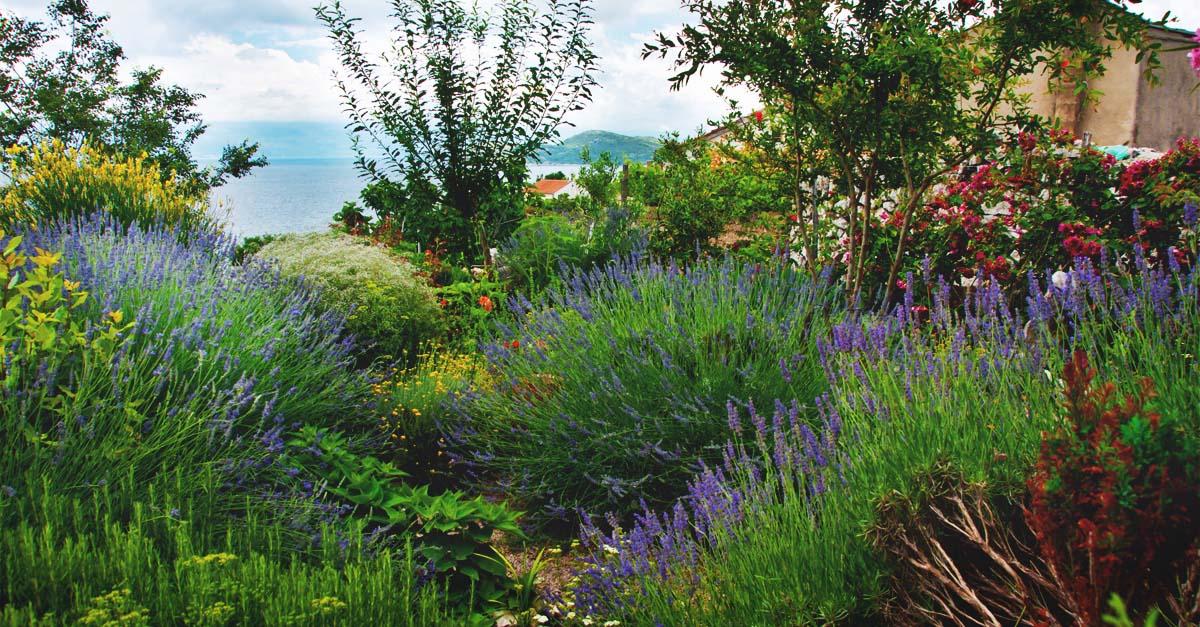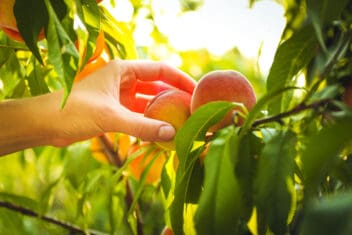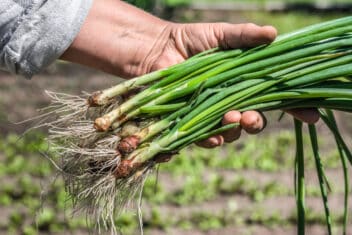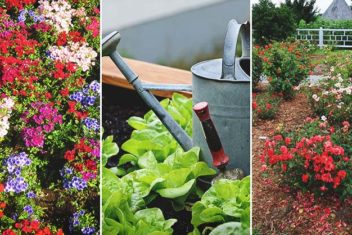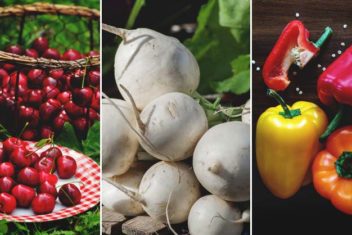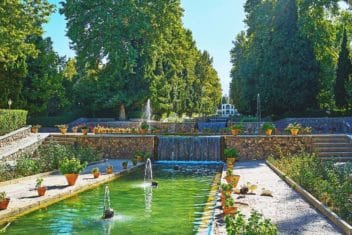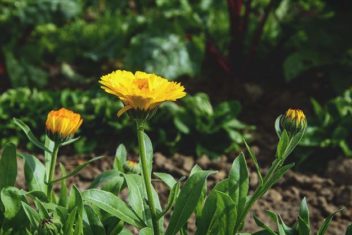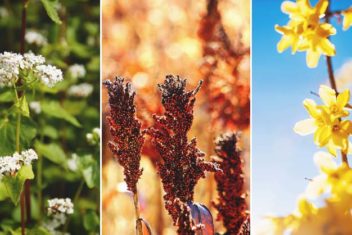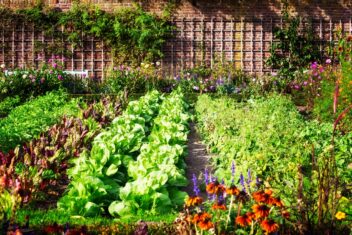Imagine a walled courtyard, filled with pungent herbs and vibrant flowers in overflowing pots. Sweet smells fill your nose, soft colors please the eyes, and gurgling water delights your ears. Welcome to the Mediterranean garden.
Who wouldn’t want to bring home some of the Mediterranean life? Think of the warm beaches, cobbled streets, and outdoor cafes. You can replicate the gardens and walled havens of southern Europe to bring a little of the good life to your own space.
Life along the southern European coastline lends itself to the outdoors. Families can dine, garden, and play in walled courtyards. Mediterranean gardens encourage togetherness with large outdoor tables, bocce ball courts, tiered fountains, and herb gardens.
Ready to make the Mediterranean vibe part of your life? Here’s how:
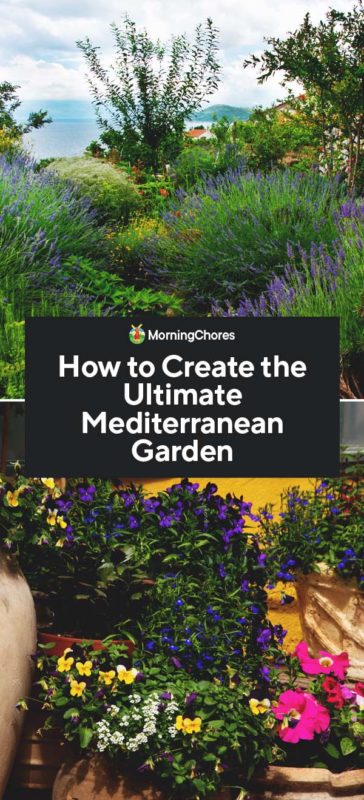
Plants For A Mediterranean Garden
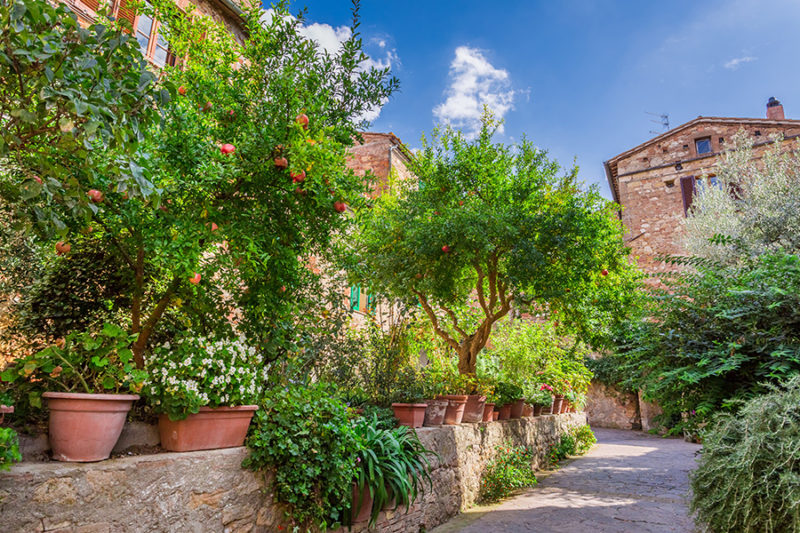
Plants in southern Europe share some characteristics. Generally, they are drought-tolerant, hardy in warm weather, and have blue/green foliage and purple or yellow blossoms. Typically, they are sun lovers and are low-maintenance. They don’t do well in cold weather or with frost.
A Mediterranean garden will fit in anywhere in the country as long as you match your plants with your agricultural planting zone. Live in a section of the country that experiences droughts? Mediterranean plants are ones that require less water and fertilizer, so they fit in well with xeriscaping. Live in a colder, wetter area? There are plants for your space, too.
One of the best things about a Mediterranean garden is that it attracts the beneficial creatures and repels the pests. Butterflies and hummingbirds love the flowers, and deer will avoid them. Several of the Mediterranean herbs are natural repellents to many insect pests.
Herbs
Many beloved herbs come from the region and bring a delightful flavor to French, Italian, and Greek dishes.
These herbs all do well in sandy, loamy soil. They don’t like wet feet, so well-drained soil is a must. I don’t have this soil naturally. In fact, I have the complete opposite. If you have the same problem, these herbs may do better in a raised bed so you can control the soil and make it ideal for your herbs and flowers. The following are some herbs to include:
Plants for Dry Areas
To fill in the rocky and sandy areas characteristic of a Mediterranean garden, check out:
- Sedum
- Aloe
- Mullein
- Wormwood
- Yarrow
- Daisy
- Agave
Flowers
A few flowers add color and attract pollinators to your garden. Consider planting:
- California Poppies
- Daphne
- Ranunculus
- Lillies of the Nile
- Artemisia
- Russian Sage
- Salvia
- Blue fescue
- Geranium
- Lambs Ear
Climbing Plants
If you plan on using a pergola to shade your garden area, the following are great climbers and can handle warn, dry conditions:
- Grapes
- Hops
- Wisteria
- Jasmine
- Roses
- Lilacs
- Dwarf Olive
- Bay
Vegetables
Any Mediterranean garden worth its salt has something edible in it. Whether you want to focus on them or just have a few vegetables tucked in among the flowers, you should consider adding a few of these edibles to your garden scheme:
- Eggplant
- Tomatoes
- Garlic
- Onion
- Peppers
- Zucchini
- Artichoke
Add a Pergola

Having a shaded outdoor sitting area to enjoy a nice dinner or relax when the kids are napping is essential to creating a Mediterranean garden.
Pergolas, in particular, let you bring home some of that southern European laid-back lifestyle. A pergola is simply a wood or metal structure that creates a cover over a walkway or sitting area. Traditionally, it’s covered in plants to create a naturally shaded space.
Woody climbing plants make the best covers. In Europe, they often use grapevines. Some other options are wisteria, roses, hops, and jasmine. Choose varieties that have scented leaves or flowers for additional sensory delight.
DIY Pergola
Pergolas can be pricey, so why not build one over an existing deck? Viola! Instant Mediterranean garden.
When putting up a pergola, make sure you have a sturdy platform on which to place it. No rotting wood or uneven concrete. If your deck is older, you may want to redo it first.
For stability, a pergola needs eight support beams for a 10×10 structure. If you’re in a windy area, take extra precautions and use strong ties, timber bolts and hurricane straps for added protection.
The rafters can be dimensional lumber or lattice covering. Give some thought to what variety of climbing plants you want to add. Make sure that the wood or lattice is close enough together so that the plants can stretch between the wood.
When building your pergola, remember to leave adequate space for planting. If you plan on using raised beds, make sure that they’re deep and wide enough to hold a growing climber. Plants growing on pergolas need extra nutrition to encourage lots of leaf and stem production.
Using Gravel and Rocks
Mediterranean coasts are rocky, which adds a wonderful visual texture. You can mimic this look by spreading gravel in a garden area and adding some larger rocks for accents. Gravel patios have the advantage of keeping out weeds while at the same time letting water drain through.
Winding gravel and stone pathways make a small space seem bigger. Put a bench at the end of a path for a focal point and a place to take a break.
Adding larger shrubs either in pots or planted in the ground gives visual interest. Shrubs and small trees create a visual foundation and pull everything together.
Water Features
Listening to the sounds of water is undeniably pleasant, and a common element in a Mediterranean garden. Bring some of those relaxing sounds into your garden with a water feature.
The tiered water fountain dates back to ancient Greek and Roman times. A fountain can be basic, with a few levels of overflowing water, or elaborate with carvings of people or animals.
Water fountains add a sense of peacefulness to your garden, and they can act as birdbaths as well. In-ground ponds hold fish and attract native frogs and salamanders.
Urban Mediterranean Gardens
One of the most important things you need to determine is how much space you have to dedicate to a Mediterranean garden. If you live in an urban area, you aren’t excluded from the fun.
In childhood trips to see family in Italy, I always marveled at the plants that grow everywhere along the cobbled streets. Pots are set on steps and on the sidewalk, and window boxes abound everywhere, even in cities.
One thing they do well in the region is to use every nook and cranny. In fact, the Europeans love window boxes so much you frequently see them attached to the walls of buildings. Tomatoes, herbs, and flowers all spill out of pots attached to the walls. The use of all available space to add plants delights me.
That is why Mediterranean gardens do so well for urban dwellers who are limited in space. This style of gardening lends itself to small spaces and makes tiny areas seem bigger and fuller. In addition, Mediterranean plants do well with the dryer soil you find in containers.
Container Planting
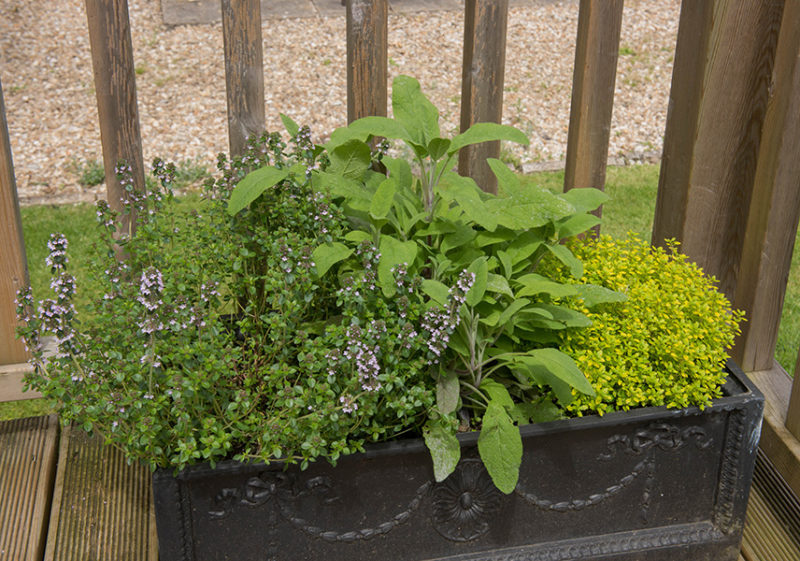
If you live in an urban space, consider container planting. One of the fun things about using containers is that there are lots of different styles and materials available. Terra Cotta, plastic, resin, and tufa pots can all fit into your design.
Any time you use pots or containers, you need to remember to check the moisture level. Pots dry out quicker than garden areas and need frequent watering. Adding a saucer beneath your pots will help to catch the water for future drinks for your plants.
As an added bonus, pots look fabulous when they are used as a focal point. A large urn with herbs such as thyme gracefully overflowing with some sweet-smelling lavender can make a patio pop. Any pot will last longer if stored inside during the winter months. When I am doing my fall cleanup, I store mine away in a shed. Next season I plant them with something different to rotate my crops.
Terra Cotta
The aesthetic of terra cotta fits in nicely with the Mediterranean theme. Additionally, plants are less likely to get knocked over in a windstorm or by the kids roughhousing because terra cotta is heavy. They’re also perfect for hot climates because they retain heat and cool via evaporation.
Plastic
Plastic pots are lightweight, which is useful on a deck or rooftop. You can get plastic pots in an amazing array of styles and colors. I like them because they are useful in decorating, and I can get them to match my trim or deck furniture. One disadvantage is that plastic pots tend to dry out quickly. They also don’t hold up well and crack after only a couple of seasons.
Tufa
Tufa, or hypertufa, is a lightweight material made from mixing Portland cement, peat moss, and perlite together. You can make your own in an easy DIY project.
Tufa containers are lighter then terra cotta and more resilient than plastic. In my climate, they eventually crack and split. I have broken off old ones and used the pieces for drainage at the bottom of new ones.
The Bottom Line on Creating a Mediterranean Garden
The Mediterranean Garden Society says that creating an ideal Mediterranean garden is all about making something that is in “sympathy with the natural surroundings and our philosophy of waterwise gardening.”
I would take that a step further. A Mediterranean garden brings a sense of community with family and friends. It provides a place to enjoy a good meal together, to experience the natural world or play a fun outdoor game. On top of that, it’s a guideline for keeping a garden that will make your senses come alive.
